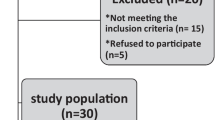Abstract
Perianal fistulas and abscesses may be cryptogenetic or associated with inflammatory bowel disease (IBD), specifically Crohn’s disease. Proper identification and classification of these lesions are paramount for correct therapeutic management. Current diagnostic modalities include MRI (magnetic resonance imaging), EUS (endoscopic ultrasound), EUA (exam under anaesthesia) and recently, transperineal ultrasound (TPUS). The latter has been proposed as a noninvasive, easily available and cost-effective technique to diagnose, assess and follow up perianal disease particularly in IBD patients. This pictorial review focuses on the role of TPUS in clinical practice, highlighting the features of fistulas and abscesses.
















Similar content being viewed by others
References
Nuernberg D, Saftoiu A, Barreiros AP et al (2019) EFSUMB recommendations for gastrointestinal ultrasound part 3: endorectal, endoanal and perineal ultrasound. Ultrasound Int Open 5:E34–E51
Hertzberg BS, Bowie ID, Weber TM et al (1991) Sonography of the cervix during the third trimester of pregnancy: value of the transperineal approach. Am J Roentgenol 157:73–76
Oppenheimer DA, Carroll BA, Shochat SJ (1983) Sonography of imperforate anus. Radiology 148:127–128
Teele RL, Share JC (1997) Transperineal sonography in children. Am J Roentgenol 168:1263–1267
Parks AG, Gordon PH, Hardcastle JD (1976) A classification of fistula-in-ano. Br J Surg 63:1–12
Rasul I, Wlson SR, MacRae H et al (2003) Clinical and radiological response after infliximab treatment for perianal fistulizing Crohn’s disease. Am J Gastroenterol 99:82–88
Bataille F, Klebl F, Rümmele P et al (2004) Morphological characterisation of Crohn’s disease fistulae. Gut 53:1314–1321
Maconi G, Greco MT, Asthana AK (2017) Transperineal ultrasound for perianal fistulas and abscesses—a systematic review and meta-analysis. Ultraschall Med 38:265–272
Zbar AP, Horesh N, Bucholtz V, Zmora O, Beer-Gabel M, Carter D (2013) Are there specific endosonographic features in Crohn’s patients with perianal fistulae? J Crohns Colitis 7:490–496
Present DH, Rutgeerts P, Targan S et al (1999) Infliximab for the treatment of fistulas in patients with Crohn’s disease. N Engl J Med 340:1398–1405
Losco A, Viganò C, Conte D et al (2009) Assessing the activity of perianal Crohn’s disease: comparison of clinical indices and computer-assisted anal ultrasound. Inflamm Bowel Dis 15:742–749
Allgayer H, Ignee A, Dietrich CF (2010) Endosonographic elastography of the anal sphincter in patients with fecal incontinence. Scand J Gastroenterol 45:30–38
Terracciano F, Scalisi G, Bossa F et al (2016) Transperineal ultrasonography: first level exam in IBD patients with perianal disease. Dig Liver Dis 48:874–879
Bezzio C, Bryant RV, Manes G et al (2017) New horizons in the imaging of perianal Crohn’s disease: transperineal ultrasonography. Expert Rev Gastroenterol Hepatol 28:1–8
Acknowledgements
Authors thank Richa Chibbar from Department of Gastroenterology, Beth Israel Deaconess Medical Centre, Boston MA, USA, for help in the editing and revision of the manuscript.
Funding
This study was not funded.
Author information
Authors and Affiliations
Corresponding author
Ethics declarations
Conflict of interest
The authors declare that they have no conflict of interest with this manuscript.
Ethical approval
This article does not contain any studies with human participants or animals performed by any of the authors.
Additional information
Publisher's Note
Springer Nature remains neutral with regard to jurisdictional claims in published maps and institutional affiliations.
Rights and permissions
About this article
Cite this article
Lavazza, A., Maconi, G. Transperineal ultrasound for assessment of fistulas and abscesses: a pictorial essay. J Ultrasound 22, 241–249 (2019). https://doi.org/10.1007/s40477-019-00381-6
Received:
Accepted:
Published:
Issue Date:
DOI: https://doi.org/10.1007/s40477-019-00381-6




